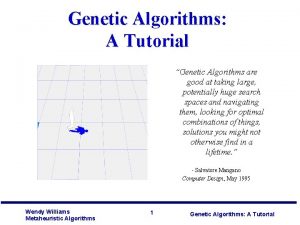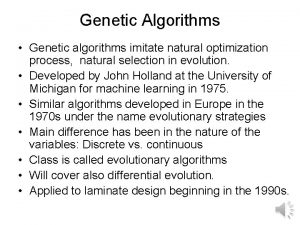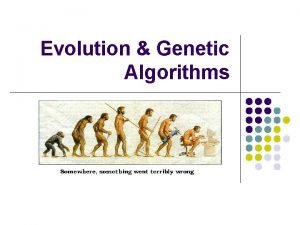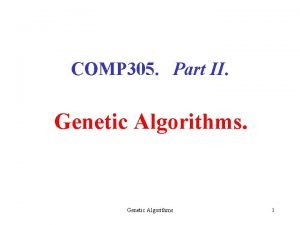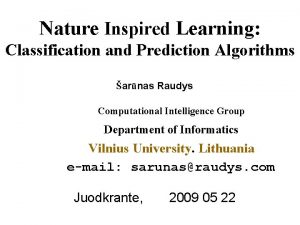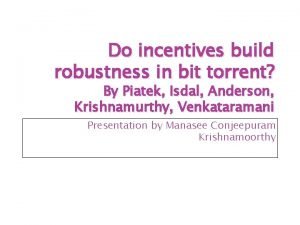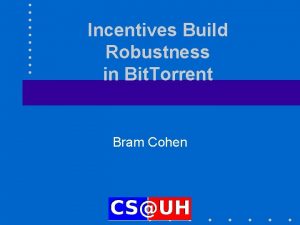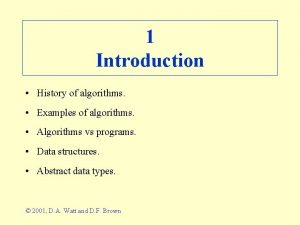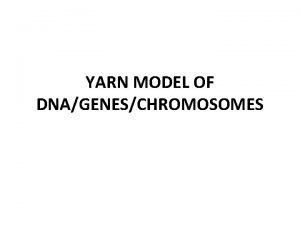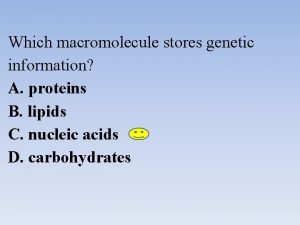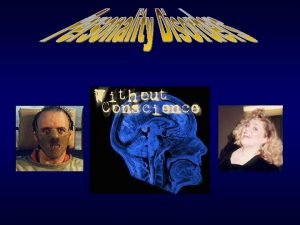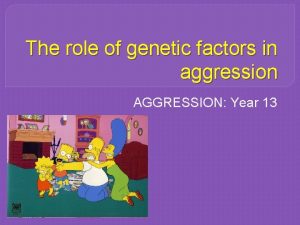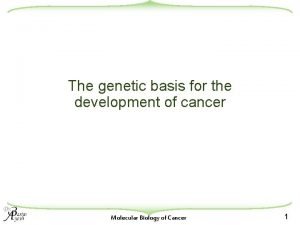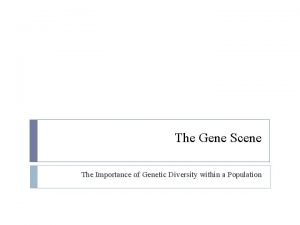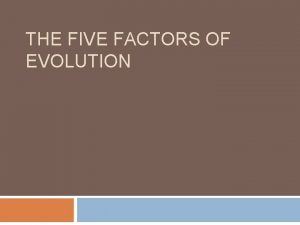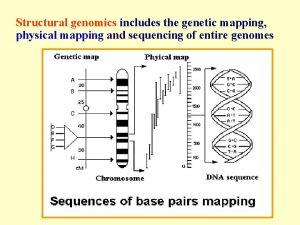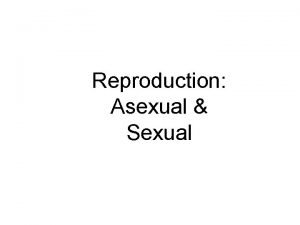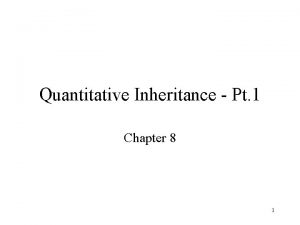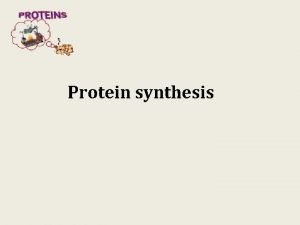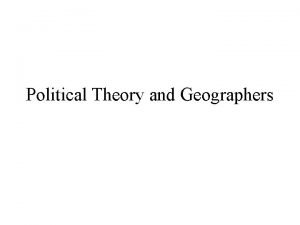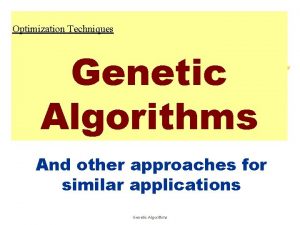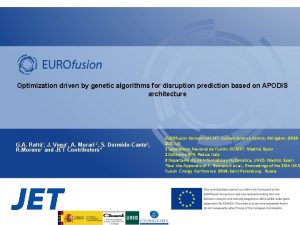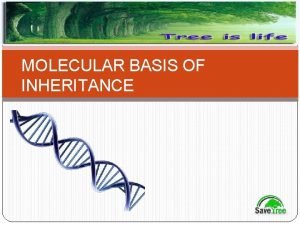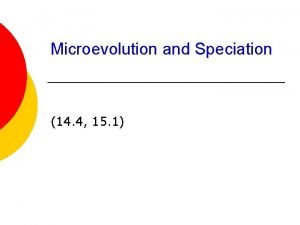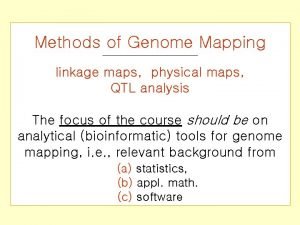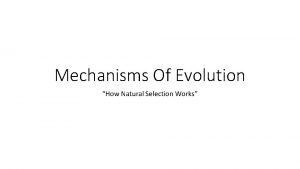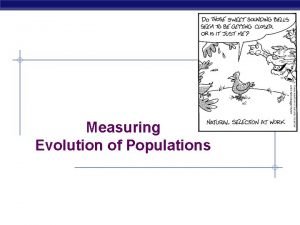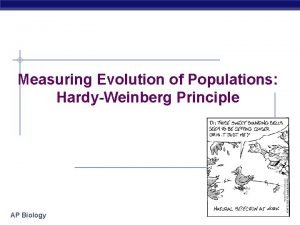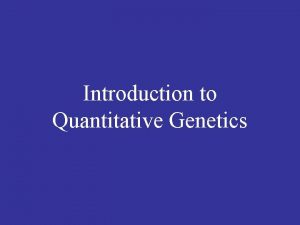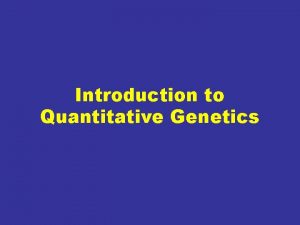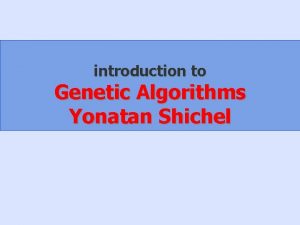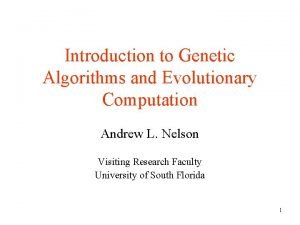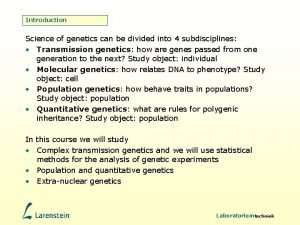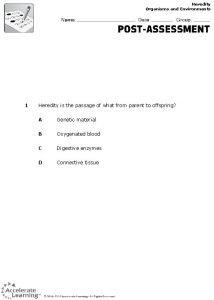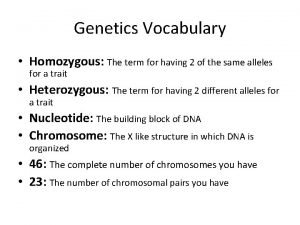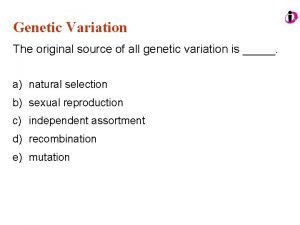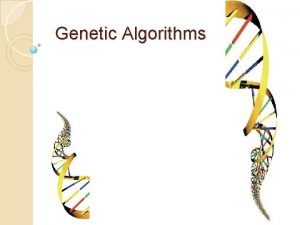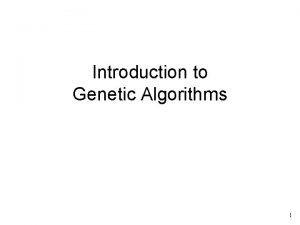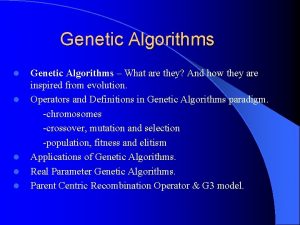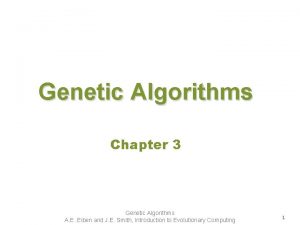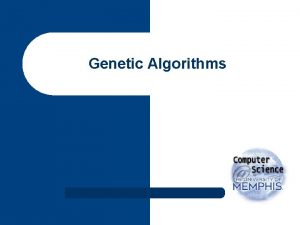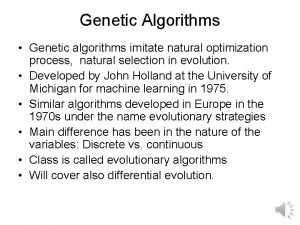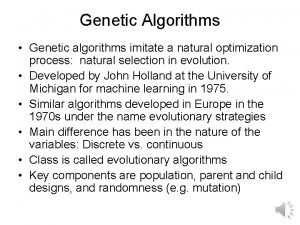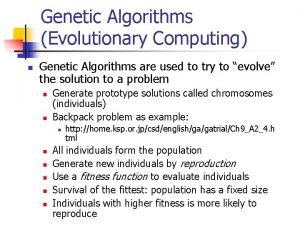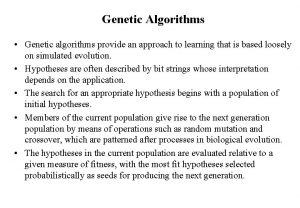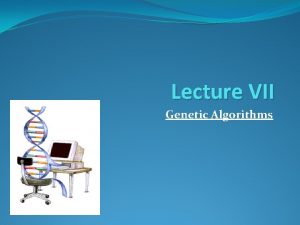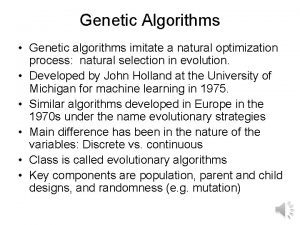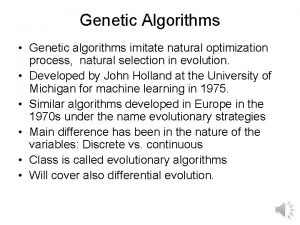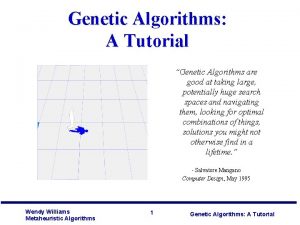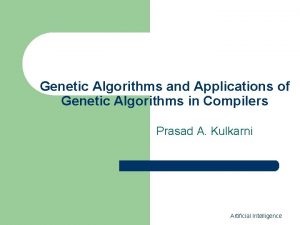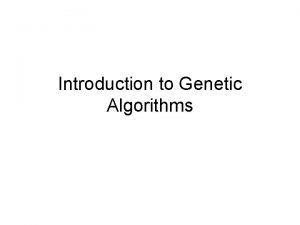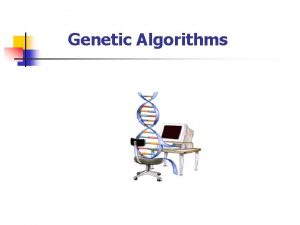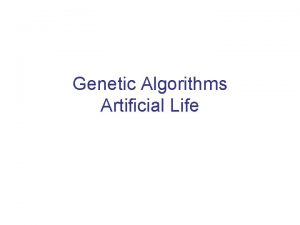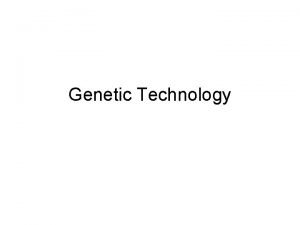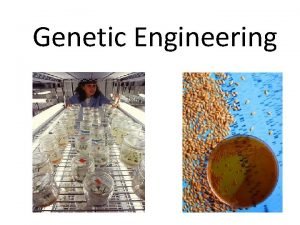Algorithms in Nature Genetic algorithms History History of




















































- Slides: 52

Algorithms in Nature Genetic algorithms

History

History of GAs • As early as 1962, John Holland's work on adaptive systems laid the foundation for later developments. • By the 1975, the publication of the book Adaptation in Natural and Artificial Systems, by Holland his students and colleagues.

History of GAs • early to mid-1980 s, genetic algorithms were being applied to a broad range of subjects. • In 1992 John Koza has used genetic algorithm to evolve programs to perform certain tasks. He called his method "genetic programming" (GP).

What is GA • A genetic algorithm (or GA) is a search technique used in computing to find true or approximate solutions to optimization and search problems. • (GA)s are categorized as global search heuristics. • (GA)s are a particular class of evolutionary algorithms that use techniques inspired by evolutionary biology such as inheritance, mutation, selection, and crossover (also called recombination).

What is GA • The evolution usually starts from a population of randomly generated individuals and happens in generations. • In each generation, the fitness of every individual in the population is evaluated, multiple individuals are selected from the current population (based on their fitness), and modified to form a new population.

What is GA • The new population is used in the next iteration of the algorithm. • The algorithm terminates when either a maximum number of generations has been produced, or a satisfactory fitness level has been reached for the population. No convergence rule or guarantee!

Vocabulary • Individual - Any possible solution • Population - Group of all individuals • Fitness – Target function that we are optimizing (each individual has a fitness) • Trait - Possible aspect (features) of an individual • Genome - Collection of all chromosomes (traits) for an individual.

Basic Genetic Algorithm • Start with a large “population” of randomly generated “attempted solutions” to a problem • Repeatedly do the following: – Evaluate each of the attempted solutions – (probabilistically) keep a subset of the best solutions – Use these solutions to generate a new population • Quit when you have a satisfactory solution (or you run out of time)

Example: the MAXONE problem Suppose we want to maximize the number of ones in a string of l binary digits Is it a trivial problem? It may seem so because we know the answer in advance However, we can think of it as maximizing the number of correct answers, each encoded by 1, to l yes/no difficult questions` 10

• Example An individual(cont) is encoded (naturally) as a string of l binary digits • The fitness f of a candidate solution to the MAXONE problem is the number of ones in its genetic code • We start with a population of n random strings. Suppose that l = 10 and n = 6 11

Example (initialization) We toss a fair coin 60 times and get the following initial population: s 1 = 1111010101 f (s 1) = 7 s 2 = 0111000101 f (s 2) = 5 s 3 = 1110110101 f (s 3) = 7 s 4 = 010011 f (s 4) = 4 s 5 = 11101 f (s 5) = 8 s 6 = 0100110000 f (s 6) = 3 12

Step 1: Selection We randomly (using a biased coin) select a subset of the individuals based on their fitness: f (i) Individual i will have a probability to be chosen 1 2 n 3 f (i) i Area is Proportional to fitness value 4 13

Selected set Suppose that, after performing selection, we get the following population: s 1` = 1111010101 (s 1) s 2` = 1110110101 (s 3) s 3` = 11101 (s 5) s 4` = 0111000101 (s 2) s 5` = 010011 (s 4) s 6` = 11101 (s 5) 14

Step 2: crossover • Next we mate strings for crossover. For each couple we first decide (using some pre-defined probability, for instance 0. 6) whether to actually perform the crossover or not • If we decide to actually perform crossover, we randomly extract the crossover points, for instance 2 and 5 15

Crossover result Before crossover: s 1` = 1111010101 s 2` = 1110110101 After crossover: s 1`` = 1110110101 s 2`` = 1111010101 16

Step 3: mutations The final step is to apply random mutations: for each bit that we are to copy to the new population we allow a small probability of error (for instance 0. 1) Initial strings After mutating s 1`` = 1110110101 s 1``` = 1110100101 s 2`` = 1111010101 s 2``` = 1111110100 s 3`` = 11101 s 3``` = 1110101111 s 4`` = 0111000101 s 4``` = 0111000101 s 5`` = 0100011101 s 5``` = 0100011101 s 6`` = 1110110011 s 6``` = 1110110001 17

And now, iterate … In one generation, the total population fitness changed from 34 to 37, thus improved by ~9% At this point, we go through the same process all over again, until a stopping criterion is met

Biological motivation

Biological Background “The cell” • Every animal cell is a complex of many small “factories” working together. • The nucleus in the center of the cell. • The nucleus contains the genetic information

Biological Background “Chromosomes” • Genetic information is stored in the chromosomes • Each chromosome is built of DNA • Genes are encoded in the chromosomes • Genes code for proteins • Every gene has a unique position on the chromosome

Biological Background: Genotype and phenotype • The entire combination of genes is called genotype • A genotype leads to a phenotype (eye color, height, disease predisposition) • The phenotype is affected by changes to the underlying genetic code

Biological Background “Reproduction ” • Reproduction of genetical information • Mitosis • Meiosis • Mitosis is copying the same genetic information to new offspring: there is no exchange of information • Mitosis is the normal way of growing of multicell structures, like organs.

Biological Background Reproduction • Meiosis is the basis of sexual reproduction • After meiotic division 2 gametes appear • In reproduction two gametes conjugate to a zygote which will become the new individual • Crossovers leads to new genotype

Mutations • In any copying process errors can occur, so single (point) mutations ate pretty common. • Other types of errors, including affecting longer regoins (either deletion, inversions, substitutions etc. ) can also occur

“Natural selection” • The origin of species: “Preservation of favourable variations and rejection of unfavourable variations. ” • There are more individuals born than can survive, so there is a continuous struggle for life. • Individuals with an advantage have a greater chance for survive: so survival of the fittest.

GA Operators • Methods of representation • Methods of selection • Methods of Reproduction

Common representation methods • • Binary strings. Arrays of integers (usually bound) Arrays of letters ….

Methods of Selection There are many different strategies to select the individuals to be copied over into the next generation

Methods of Selection • • • Roulette-wheel selection. Elitist selection. Fitness-proportionate selection. Scaling selection. Rank selection. …

Roulette wheel selection • Conceptually, this can be represented as a game of roulette - each individual gets a slice of the wheel, but more fit ones get larger slices than less fit ones.

Roulette wheel selection No. String Fitness % Of Total 1 01101 169 14. 4 2 11000 576 49. 2 3 01000 64 5. 5 4 10011 361 30. 9 1170 100. 0 Total

Other selection methods • Elitist selection: Chose only the most fit members of each generation. • Cutoff selection: Select only those that are above a certain cutoff for the target function.

Methods of Reproduction • There are primary methods: –Crossover –Mutation

Methods of Reproduction: Crossover – Two parents produce two offspring – Two options: 1. The chromosomes of the two parents are copied to the next generation 2. The two parents are randomly recombined (crossed-over) to form new offsprings

Several possible crossover strategies • Randomly select a single point for a crossover • Multi point crossover • Uniform crossover

Two-point crossover • Avoids cases where genes at the beginning and end of a chromosome are always split Parent s: 101000111 0 001101001 0 Offsprin g: 010101001 0 00111 0

• Single point crossover Crossov er Cross point • Two point crossover (Multi point crossover)

Uniform crossover • A random subset is chosen • The subset is taken from parent 1 and the other bits from parent 2. Subset: BAABBB (Randomly generated) Parents: 1010001110 0011010010 Offspring: 0011001010010110

Methods of Reproduction: Mutations – Generating new offspring from single parent

A (slightly more involved) example The Traveling Salesman Problem: Find a tour of a given set of cities so that – each city is visited only once – the total distance traveled is minimized

Representation is an ordered list of city numbers known as an order-based GA. 1) London 2) Venice 3) Dunedin 4) Singapore 5) Beijing 7) Tokyo 6) Phoenix 8) Victoria City. List 1 (3 5 7 2 1 6 4 8) City. List 2 (2 5 7 6 8 1 3 4)

Crossover combines inversion and recombination: * * Parent 2 (3 5 7 2 1 6 4 8) (2 5 7 6 8 1 3 4) Child (5 8 7 2 1 6 3 4) Parent 1 This operator is called the Order 1 crossover.

Mutation involves reordering of the list: Before: * * (5 8 7 2 1 6 3 4) After: (5 8 6 2 1 7 3 4)

TSP Example: 30 Cities 120 100 80 y 60 40 20 0 0 10 20 30 40 50 x 60 70 80 90 100

Solution i (Distance = 941) TSP 30 (Performance = 941) 120 100 80 y 60 40 20 0 0 10 20 30 40 50 x 60 70 80 90 100

Solution j(Distance = 800) TSP 30 (Performance = 800) 120 100 80 y 60 40 20 0 0 10 20 30 40 50 x 60 70 80 90 100

Solution k(Distance = 652) TSP 30 (Performance = 652) 120 100 80 y 60 40 20 0 0 10 20 30 40 50 x 60 70 80 90 100

Best Solution (Distance = 420) TSP 30 Solution (Performance = 420) 120 100 80 y 60 40 20 0 0 10 20 30 40 50 x 60 70 80 90 100

GA Applications Domain Application Type Control Gas pipeline, missile evasion Design Aircraft design, keyboard configuration, communication networks Game playing Poker, checkers Security Encryption and Decryption Robotics Trajectory planning

Benefits of Genetic Algorithms • • • Concept is easy to understand Modular, separate from application Supports multi-objective optimization Always an answer; answer gets better with time. Easy to exploit previous or alternate solutions Flexible building blocks for hybrid applications.

Automatic design and manufacture of robotic lifeforms Biological life is in control of its own means of reproduction. . . But this autonomy of design and manufacture has not yet been realized artificially… Here we report the results of a combined computational and experimental approach in which simple electromechanical systems are evolved through simulations from basic building blocks (bars, actuators and artificial neurons); the 'fittest' machines are then fabricated robotically. . . We thus achieve autonomy of design and construction using evolution in a 'limited universe' physical simulation coupled to automatic fabrication. Nature 2000
 Founder population
Founder population Genetic programming vs genetic algorithm
Genetic programming vs genetic algorithm Genetic programming vs genetic algorithm
Genetic programming vs genetic algorithm Genetic drift vs gene flow
Genetic drift vs gene flow Gene flow vs genetic drift
Gene flow vs genetic drift Genetic algorithms tutorial
Genetic algorithms tutorial Genetic algorithms
Genetic algorithms Genetic algorithms
Genetic algorithms Dairy comp 305 tutorial
Dairy comp 305 tutorial Nature-inspired learning algorithms
Nature-inspired learning algorithms Tft
Tft Incentives build robustness in bittorrent
Incentives build robustness in bittorrent Nature and nature's laws lay hid in night meaning
Nature and nature's laws lay hid in night meaning Nature nature controversy
Nature nature controversy History of algorithms
History of algorithms Yarn model
Yarn model Which type of macromolecule stores genetic information
Which type of macromolecule stores genetic information Is psychopathy genetic
Is psychopathy genetic Genetic vocabulary worksheet answer key
Genetic vocabulary worksheet answer key Outline the role of genetic factors in aggression
Outline the role of genetic factors in aggression The genetic basis of cancer
The genetic basis of cancer Why is genetic diversity important
Why is genetic diversity important Five factors of evolution
Five factors of evolution Heterozygous dominant
Heterozygous dominant Genetic vs physical map
Genetic vs physical map Master horizons
Master horizons Sexual reproduction
Sexual reproduction Components of genetic variation
Components of genetic variation Narrow sense heritability vs broad sense heritability
Narrow sense heritability vs broad sense heritability Genetic code table
Genetic code table Genetic boundary definition
Genetic boundary definition Genetic vs physical map
Genetic vs physical map Single point crossover in genetic algorithm
Single point crossover in genetic algorithm Fitness function in genetic algorithm
Fitness function in genetic algorithm Deoxyribose nucleotide
Deoxyribose nucleotide Chapter 12 section 1 dna the genetic material
Chapter 12 section 1 dna the genetic material Rho factor
Rho factor Microevolution
Microevolution Genetic map vs physical map
Genetic map vs physical map Genetic recombination
Genetic recombination Mechanisms of evolutionary
Mechanisms of evolutionary What is gene flow and genetic drift
What is gene flow and genetic drift Genetic drift vs gene flow
Genetic drift vs gene flow Inheritance of quantitative traits
Inheritance of quantitative traits Dominant genetic variance
Dominant genetic variance Single point crossover in genetic algorithm
Single point crossover in genetic algorithm Fitness function
Fitness function Genetics
Genetics Chapter 11 genetic disorders concept mapping
Chapter 11 genetic disorders concept mapping Heredity defines the passage of genetic material from
Heredity defines the passage of genetic material from Genetic vocabulary review
Genetic vocabulary review Genetics vocab
Genetics vocab The original source of all genetic variation is _____
The original source of all genetic variation is _____





